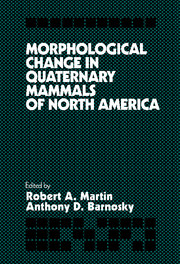Book contents
- Frontmatter
- Contents
- List of Contributors
- Acknowledgments
- 1 Quaternary mammals and evolutionary theory: introductory remarks and historical perspective
- 2 A method for recognizing morphological stasis
- 3 Mosaic evolution at the population level in Microtus pennsylvanicus
- 4 Variogram analysis of paleontological data
- 5 Morphological change in Quaternary mammals: a role for species interactions?
- 6 Rates of evolution in Plio-Pleistocene mammals: six case studies
- 7 Patterns of dental variation and evolution in prairie dogs, genus Cynomys
- 8 Quantitative and qualitative evolution in the giant armadillo Holmesina (Edentata: Pampatheriidae) in Florida
- 9 Evolution of mammoths and moose: the Holarctic perspective
- 10 Evolution of hypsodonty and enamel structure in Plio-Pleistocene rodents
- 11 Patterns of variation and speciation in Quaternary rodents
- 12 Decrease in body size of white-tailed deer (Odocoileus virginianus) during the late Holocene in South Carolina and Georgia
- 13 Short–term fluctuations in small mammals of the late Pleistocene from eastern Washington
- 14 Size change in North American Quaternary jaguars
- 15 Ontogenetic change of Ondatra zibethicus (Arvicolidae, Rodentia) cheek teeth analyzed by digital image processing
- 16 Morphological change in woodrat (Rodentia: Cricetidae) molars
- Index
8 - Quantitative and qualitative evolution in the giant armadillo Holmesina (Edentata: Pampatheriidae) in Florida
Published online by Cambridge University Press: 15 December 2009
- Frontmatter
- Contents
- List of Contributors
- Acknowledgments
- 1 Quaternary mammals and evolutionary theory: introductory remarks and historical perspective
- 2 A method for recognizing morphological stasis
- 3 Mosaic evolution at the population level in Microtus pennsylvanicus
- 4 Variogram analysis of paleontological data
- 5 Morphological change in Quaternary mammals: a role for species interactions?
- 6 Rates of evolution in Plio-Pleistocene mammals: six case studies
- 7 Patterns of dental variation and evolution in prairie dogs, genus Cynomys
- 8 Quantitative and qualitative evolution in the giant armadillo Holmesina (Edentata: Pampatheriidae) in Florida
- 9 Evolution of mammoths and moose: the Holarctic perspective
- 10 Evolution of hypsodonty and enamel structure in Plio-Pleistocene rodents
- 11 Patterns of variation and speciation in Quaternary rodents
- 12 Decrease in body size of white-tailed deer (Odocoileus virginianus) during the late Holocene in South Carolina and Georgia
- 13 Short–term fluctuations in small mammals of the late Pleistocene from eastern Washington
- 14 Size change in North American Quaternary jaguars
- 15 Ontogenetic change of Ondatra zibethicus (Arvicolidae, Rodentia) cheek teeth analyzed by digital image processing
- 16 Morphological change in woodrat (Rodentia: Cricetidae) molars
- Index
Summary
The formation of the Panamanian isthmus in the late Pliocene permitted widespread faunal interchange between North and South America. Previously, edentates (or xenarthrans) had been limited to South America since the Paleogene and had there undergone a moderate radiation into three major clades: the shelled cingulates (three families), the anteaters (one family), and the sloths (a minimum of four families). Two sloth genera, Thinobadistes and Pliometanastes, appeared in North America in the late Miocene, heralding the forthcoming interchange. The emergence of Panama increased the probability of faunal interchange, and eight edentate families dispersed into North America during the late Pliocene or early Pleistocene with varying success. The Pampatheriidae is a distinct lineage of shelled edentates, now accorded familial rank (Engleman, 1985; Edmund, 1987) and separated from both the Dasypodidae (within which they were long regarded as a subfamily) and the Glyptodontidae. Edmund (1987, pp. 6-7) listed character states that distinguish pampatheres from the other two cingulate families.
The presence of pampatheres in North America was first recognized by Leidy (1889) on the basis of isolated osteoderms collected in Florida. During the ensuing century, numerous additional specimens of pampatheres were collected in North America, predominantly from Florida, and to a lesser extent from Texas (James, 1957; Edmund, 1987). Webb (1974) and Robertson (1976) were the first to describe pre- Rancholabrean pampatheres from Florida. They demonstrated that a very large size difference separated Blancan and Rancholabrean pampatheres in Florida, with some Irvingtonian populations being of intermediate size. Prior studies had necessarily been limited to Rancholabrean specimens and thus could not have detected any significant evolutionary change.
- Type
- Chapter
- Information
- Morphological Change in Quaternary Mammals of North America , pp. 134 - 177Publisher: Cambridge University PressPrint publication year: 1993
- 7
- Cited by

